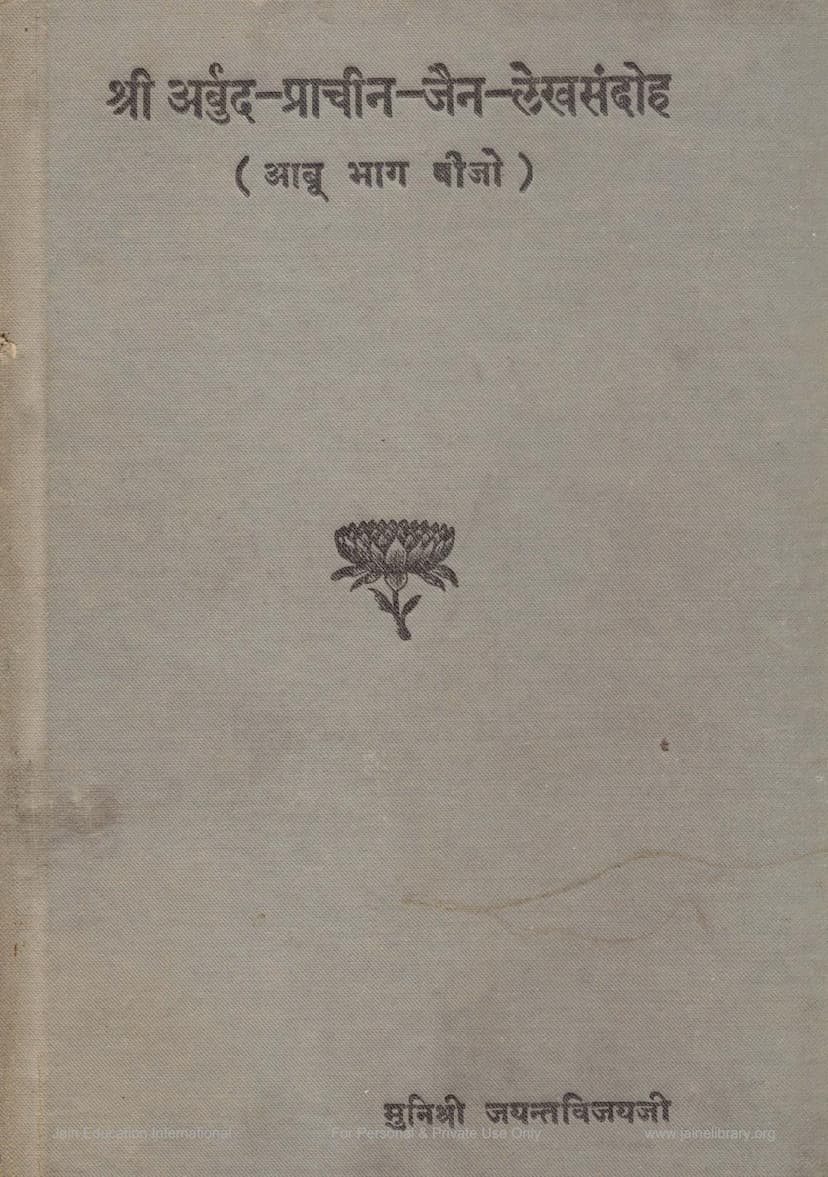Arbud Prachin Jain Lekh Sandohe Abu Part 02
Added to library: September 1, 2025

Summary
This Jain text, "Arbud Prachin Jain Lekh Sandohe Abu Part 02" (Shri Arbuda-Prachin Jain Lekh Sandoh - Abu, Part Two), compiled and edited by Munishri Jayantvijayji and published by Vijadhdharmsuri Jain Granthamala Ujjain, is a comprehensive collection and analysis of ancient Jain inscriptions found in the Abu region.
Here's a summary of its key aspects:
Core Content:
- Collection of Inscriptions: The book is primarily a compendium of ancient Jain inscriptions (Lekh) found in the Abu (Arbud) region. These inscriptions are etched on stone, metal plates, coins, and statues.
- Detailed Analysis (Avalokan): For each inscription, Munishri Jayantvijayji provides a detailed analysis and commentary. This includes:
- Literal Translation: A direct translation of the inscription's text.
- Historical Context: Explaining the historical background, the purpose of the inscription, the individuals or events mentioned, and their significance.
- Archaeological Significance: Discussing the importance of the inscription for understanding ancient Jain history, art, architecture, religious practices, and social customs.
- Linguistic Notes: Analyzing the language, script, and any peculiarities found in the inscriptions.
- Photographs and Illustrations: The book is enriched with approximately 75 photographs and illustrations of the Jain temples and their intricate carvings, providing a visual aid to the textual content.
- Focus on Abu Region: The primary geographical focus is the Abu region, specifically covering the famous Delwada and Achalgarh temples, along with other related sites.
Key Themes and Findings:
- Historical Value: The inscriptions offer invaluable primary source material for reconstructing the history of Jainism in the region, spanning several centuries. They shed light on the patronage of Jainism by rulers, ministers, merchants, and other prominent individuals.
- Art and Architecture: The detailed descriptions and photographs of temple carvings and sculptures provide insights into the artistic and architectural styles of the period, highlighting the skill and devotion of the artisans.
- Religious Practices: The inscriptions often mention the installation of deities, the establishment of temples, and the rituals associated with them, offering a glimpse into the religious life of the Jain community at that time.
- Social and Economic Information: Details about donors, their family lineages, professions, and economic activities are often found in the inscriptions, providing social and economic history.
- Biographical Information: The text includes inscriptions related to the lives and activities of various historical figures, including Jain monks, scholars, ministers, and patrons.
- Linguistic and Paleographic Importance: The inscriptions are crucial for studying the evolution of scripts and languages used in ancient India, particularly in the context of Jain literature and epigraphy.
Structure and Organization:
- Systematic Presentation: The inscriptions are presented in a systematic manner, often with numerical references, chronological ordering, and detailed analysis.
- Indexes: The book includes comprehensive indexes that are crucial for researchers. These include:
- Chronological Index of Inscriptions: Listing inscriptions by year (Samvat).
- Index of Acharyas, Sadhus, etc.: Listing the names of religious figures mentioned.
- Index of Gotras, Lineages, Clans: Detailing the genealogical information.
- Index of Castes and Communities: Listing various communities.
- Index of Places, Countries, Mountains, Rivers: Providing geographical context.
- Index of Kings and Ministers: For historical figures.
- Foreword and Publisher's Note: The book includes a foreword, providing context and acknowledging contributors, and a publisher's note from the Vijaya Dharma Suri Jain Granthamala.
- Dedication: The book is dedicated to the gurus who preached and consecrated the invaluable temples of Delwada and Achalgarh on Mount Abu, and to the devoted lay followers who built them.
Significance:
- Contribution to Jainology and Indology: This work is a significant contribution to the fields of Jainology and Indology, offering primary source material for scholarly research.
- Preservation of History: By collecting and analyzing these ancient inscriptions, the book plays a vital role in preserving Jain history and heritage for future generations.
- Accessibility: The detailed analysis and indexes make this vast body of information accessible to scholars, historians, archaeologists, and anyone interested in the rich history of Jainism and India.
- Praise from Scholars: The book received high praise from prominent scholars like Pandit Gaurishankerji Hirachandji Ojha, who recognized its immense value for historical research and considered it an indispensable resource.
In essence, "Arbud Prachin Jain Lekh Sandohe Abu Part 02" is a scholarly and visually rich resource that meticulously documents and analyzes ancient Jain inscriptions from the Abu region, offering profound insights into the religious, artistic, social, and historical landscape of ancient India.